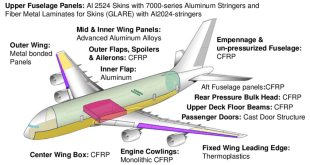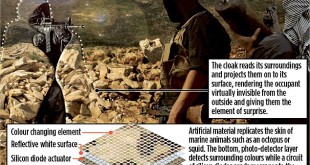To date, different types of carbon and alloy steels have proved to be the main materials of choice for naval ship construction around the world. While composites, titanium and aluminium alloys have been utilized for making hulls of smaller vessels such as patrol boats, these materials do not meet the structural requirements of the larger vessels. However new materials are being developed that offer higher performance and improved functionality.
The research project, (Lightweight Structures at Sea) LASS-C, looked at replacing the superstructure of cruise ship Norwegian Gem in composite. The major step forward in materials science means that it is now technically possible to construct ships for national and international traffic in carbon or glass fibre, while meeting classification societies’ safety requirements. This, together with new design approaches for the use of aluminium in vessels, is the result of a research project that has attracted widespread international interest, coordinated by SP Technical Research Institute of Sweden.The main challenge has been to demonstrate how ships can be built using lightweight materials without compromising with fire safety, says Tommy Hertzberg, project manager and fire research scientist with SP.
The payback period for the extra structural cost if you took the fuel savings gained from the weight reduction was 5.9 years, but the payback from income from the extra cabins you could build for the same overall weight was 2.5 years. Likewise the payback on cargo ships is quicker if you consider the potential extra payload rather than the fuel savings.
Indian Defence minister Nirmala Sitharaman commissioned in Oct 2017, the indigenously-built anti-submarine warfare stealth corvette INS Kiltan at the Eastern Naval Command here. It is India’s first major warship to have a superstructure of carbon fibre composite material resulting in improved stealth features, lower top weight and maintenance costs, it said.
British scientists and engineers have released designs for a high-tech Royal Navy vessel, offering a glimpse of navy’s advanced future warships. They suggested that warship in 2050; dubbed Dreadnought 2050 shall be a tri-hull design made of an ultra-strong, acrylic and graphene that can be turned translucent to give all-round visibility.
Lightweight materials good for the environment and for costs
There are many benefits from building in lightweight materials. Many modern ships require ballast for stability reasons. If, however, the superstructure is constructed from lightweight materials, there is less need for ballast, i.e. dead load can be replaced by pay load which is evidently highly profitable. In addition, the rising price of oil, coupled with increasingly stringent environmental requirements, means that all ways of reducing fuel consumption are of interest. Lightweight materials also bring other advantages, e.g. a reduced need for maintenance (plastic materials do not rust) and an increased life length of the vessel.
For naval ships, the flexibility of the plat-form, the potential for extra weaponry and increased speed are all attractions which can be gained through topside weight reduction as well as reduced fuel consumption or increased range.
Corrosion resistance is an obvious advantage of composites over steel in a marine environment. In addition, for military customers, the potential to incorporate smart functionality and reduce magnetic, radar and infra-red signatures is of interest. The improved thermal and acoustic insulation properties of FRP are significant in many applications, for example, cruise ship balconies where thermal bridging is a problem, cabin partitions where noise transfer must be minimized.
US Army develops new metal that can float on water and could lead to ‘indestructible’ warships
Deep Springs Technology and the US Army have created a new light weight, high strength, and heat resistant composite material, syntactic foam that could be used in warship to cars. Although syntactic foams have been around for many years, this is the first development of lightweight metal matrix syntactic foam. The secret of this syntactic foam starts with a matrix made of a magnesium alloy, which is then turned into foam by adding strong, lightweight silicon carbide hollow spheres developed and manufactured by DST.
A single sphere’s shell can withstand pressure of over 25,000 pounds per square inch (PSI) before it ruptures—one hundred times the maximum pressure in a fire hose .The magnesium alloy matrix composite reinforced with silicon carbide hollow particles has a density of only 0.92 grams per cubic centimeter compared to 1.0 g/cc of water. The new material also promises to improve automotive fuel economy because it combines light weight with heat resistance.
Indian Navy building warships using carbon fibre composite material
The Indian Navy is reportedly constructing two Kamorta-class anti-submarine warfare corvettes, using carbon fibre composite material imported from Sweden. The carbon fibre material, imported from Swedish stockyard Kockumo, is lighter than stainless-steel, which is traditionally used to construct warships. Using the new material will decrease the total weight of the vessel and increase its stealth capability.
GRSE director shipbuilding, commodore Ratnakar Ghosh said: “These are the first ships where such a technology is being used in India.”Stealth is the most important feature of composite material as it is less susceptible to detection, unlike steel.” The composite material will be used to construct the superstructure of the vessel, while the remaining sections, including the ship’s hull, will be built using stainless steel. Ghosh added: “The weight of the superstructure should be around 30% less. The cost is higher but that is offset against the long term advantages it offers.”
US Navy Gradually Embracing Composite Materials in Ships
The U.S. Navy gradually plans to incorporate composite materials into the construction of new ships. Composite materials are stronger and stiffer than metal, and for the same strength are lighter than steel and aluminum. They also are less susceptible to corrosion. They are already used in rudders, propellers, stairways, handrails, valves and armor.
Composite materials combine two or more constituent materials with significantly different physical or chemical properties that, to produce a material with improved characteristics like stronger, lighter than the individual components. The individual components remain separate and distinct within the finished structure.
On the upside, composite materials can make a ship less noisy, less detectable by radar and can help reduce the crew’s workload. For example, the DD(X) will have embedded arrays and no rotating antennas, said Foley, vice president of strategic planning for Northrop Grumman’s shipbuilding sector. Composites contribute to the overall stealth of the ship, he said. “You can make the ship stealthy in the original design and keep the ship stealthy, because composite materials do not lose their shape,” Foley explained. Those materials keep their width for over 30 years, which would be the entire lifetime of the ship.
“In a composite structure, you can do the maintenance from the inside … where it is not raining, or snowing,” Foley asserted. “You get half the size of the crew, because you do not need all the maintenance and [so] you can have much more room inside the ship.” However Ships made of composites are estimated to cost 10 percent to 20 percent more than steel ships, said Jay Foley, vice president of strategic planning for Northrop Grumman’s shipbuilding sector. They are flammable, and once aflame they create toxic smoke.
The Navy’s main reasons to use composites on its ships are the reduction in maintenance and weight, said Richard Vogelsong, a scientist at the Office of Naval Research. The Navy has researched the risks, said Vogelsong. According to him, ONR has developed certain materials to protect composites from fire, he said.
References and Resources also include:
 International Defense Security & Technology Your trusted Source for News, Research and Analysis
International Defense Security & Technology Your trusted Source for News, Research and Analysis

